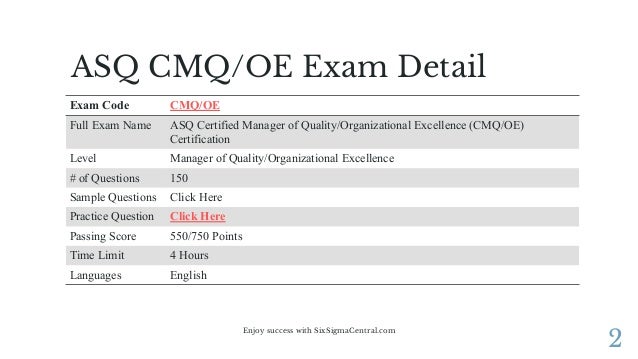Free CMQ/OE Practice Test
1. One impediment to bringing about effective change would be that the subjects being studied may intentionally or unintentionally change their behavior mainly because they’re aware they’re being monitored, and not as a result of any fundamental facets of the experiment. This is what’s called the:

Hawthorne effect
Heisenberg uncertainty principle
Ramsey factor
Godfrey ambivalence scale
CMQ/OE Exam Study Guide with Practice Questions
2. The theories of Abraham Maslow are foundational components of which of the management styles?
Scientific management
Hr management
Management by objective
Management by results
3. The data management approach in which individuals add their knowledge with a common storehouse (for instance a database) works as a:
Communities of practice strategy
Best practice transfer strategy
Codification strategy
Knowledge mapping strategy
4. Six Sigma has five phases (DMAIC), it also uses many tools that aren’t an exclusive part of the methodology. Which of the outside tools commonly doing work in Six Sigma would utilize an Ishikawa diagram?
TRIZ
Taguchi methods
Five Whys
Quality Function Deployment
5. The Rummler-Brache approach to business processes is termed the:
Theory of Constraints Model
Nine Boxes Model
Interoperability Model
Seven Circles Model
Answers
1. A: Hawthorne effect. The name emanates from studies of workers at the factory called Hawthorne Works noisy . part of the last century. Case study discovered that when workers know they’re being monitored during an asq cmq oe question bank, the outcomes from the experiment are generally unique of those achieved by workers involved in an identical experiment who will be unaware that they’re being monitored. Sometimes the real difference is positive, and quite often the real difference is negative, however, if workers know they’re being observed during an experiment, the outcomes will often be skewed, this also must be considered.
2. B: Hr management. Abraham Maslow’s theories are foundational to the human relations management style. In Maslow’s 1954 book Motivation and Personality, he proposed that humans are motivated by way of a hierarchy of needs, which a lot of people have identified as a pyramid. At the bottom are the simplest physical needs, then safety, then love/belonging, then esteem, with self-actualization at the very top. Maslow belief that no one is able for people to get the goal of meeting their higher level needs if their lower level needs aren’t already being met.
3. C: Codification strategy. The data management approach in which individuals add their knowledge with a common storehouse (for instance a database) works as a codification strategy, or push strategy. The other answer option is all instruments or strategies popular in knowledge management.
4. C: Five Whys. An Ishikawa diagram, also known as a fishbone diagram, can be included in the 5 Whys strategy for progressing to the root of the problem. The diagram concept was made by Kaoru Ishikawa, which is popular for product design and defect prevention purposes.
5. B: Nine Boxes Model. The Rummler-Brache approach to business processes is termed the Nine Boxes Model. It consists of three levels: Organization, Process, and Performer. Each level has three sections: Goals, Design, and Management. The Nine Boxes Model is frequently employed in design for employee training programs.
Check out about asq cmq oe question bank check out this internet page: read this
